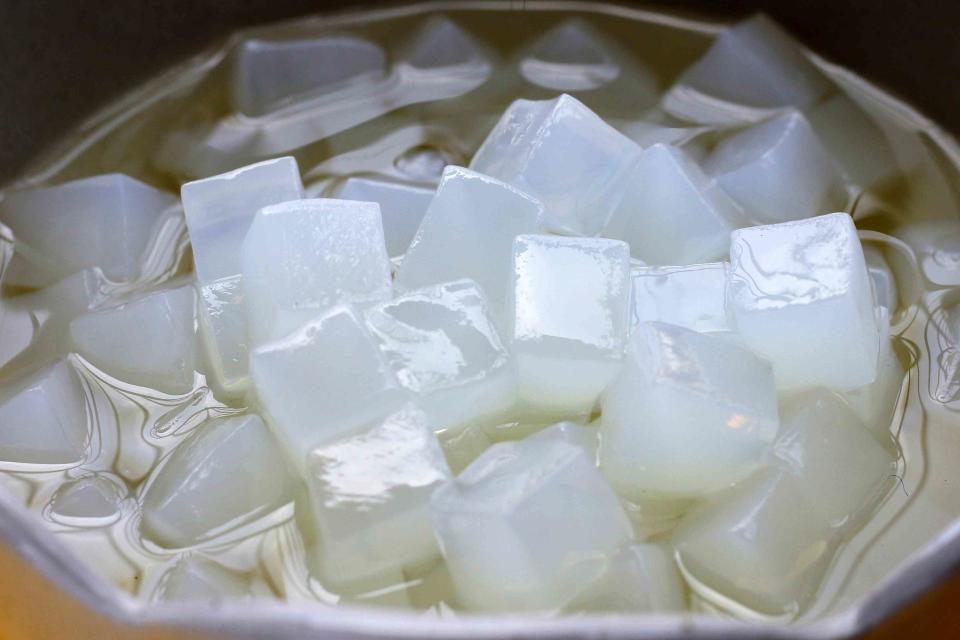If You’re a Fan of Coconut, Nata de Coco Needs to Be In Your Next Dessert
Nata de coco, a chewy coconut jelly, is a classic Filipino sweet we love on its own or mixed into desserts, cocktails and even salads.

Bowonpat Sakaew / Getty Images
A Filipino specialty, nata de coco is a gel-like coconut product widely used in desserts, such as Es Teler (Shaved Ice with Jackfruit, Avocado and Coconut) and Rum-and-Coke Shaved Ice with Coconut Jelly, as well as drinks. But what exactly is nata de coco? How is it made? More importantly, what delicious things can be made with this delectable treat?
What is nata de coco?
Nata de coco, also known as coconut gel, is a jelly-like chewy substance produced during the fermentation of coconut water. It was invented in 1949 by Teódula Kalaw África, a chemist at the Philippine Coconut Authority, who intended to make an alternative to nata de piña, itself a jelly product derived from fermented pineapple juice.
Nata de piña is a byproduct of the manufacture of piña cloth made from the fibers derived from pineapple leaves. In the 18th century, the acidic pineapple juice left to decay produced a shiny substance at the top. Soon after tasting, nata de piña became a popular treat. However, given the seasonal nature of pineapple, nata de piña was not always available. In 1949, Teódula Kalaw África published an article describing the use of coconut water as a substitute for pineapple juice since coconuts were always available and therefore easier to process into nata. During the 1970s, the current production process was introduced by Priscilla C. Sanchez, a food microbiologist, ensuring a more stable, premium nata de coco product. Today, nata de coco is produced in Malaysia, Indonesia, Thailand and Vietnam.
“Nata” is believed to be derived from the Latin word “natare”, meaning “to float,” and also the Spanish word for “cream.” Therefore, nata de coco means “cream of coconut,” or the absolute very best part of the coconut juice.
How is nata de coco made?
Nata de coco is made by boiling coconut water from mature coconuts (about 10 to 11 months old) with refined sugar, water, and glacial acetic acid (also known as vinegar acid), a clear liquid with a sour, tangy taste and odor. The mixture is then allowed to cool in trays before introducing Acetobacter xylinum, a culture grown in coconut water, necessary to produce cellulose in the nata de coco. The nata ferments for seven or more days when it firms up into sheets that are cut into small cubes, packaged, and sold in retail markets.
Where can I buy nata de coco?
Nata de coco can be found at most Asian markets or purchased online at Southeats.com, Weee!, and CVJ Asian Market.
What does nata de coco taste like?
In its raw form, nata de coco is mild and somewhat acidic, with a mild sweetnessthat makes it an ideal ingredient in desserts, cocktails, and even salads. The jelly texture works in its favor, since each bite is a burst of coconut flavor.
How is nata de coco used?
Nata de coco is used in desserts such as halo halo, Es Teler (Shaved Ice with Jackfruit, Avocado and Coconut) and Rum-and-Coke Shaved Ice with Coconut Jelly. It can be mixed into fruit salads, bubble tea, or used as a topping for ice cream or frozen yogurt. On its own, nata de coco is a refreshing and chewy snack.
For more Food & Wine news, make sure to sign up for our newsletter!
Read the original article on Food & Wine.

